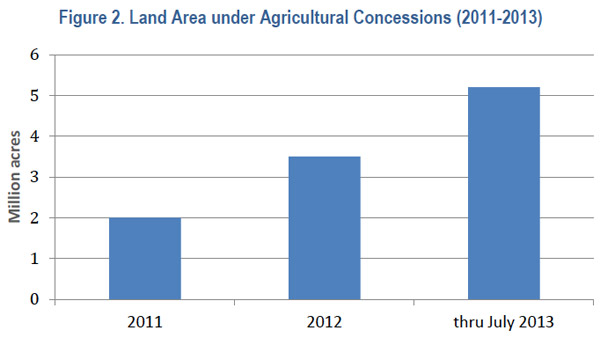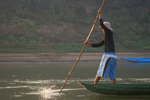As Wild Burma: Nature’s Lost Kingdom airs on the BBC, the forests documented in the series are increasingly being cut down, according to a new report by U.S. NGO Forest Trends. The report alleges that wide swathes of forest are being cleared in ethnic minority areas of Myanmar (also known as Burma), ostensibly for palm oil and rubber plantations. However after the lucrative timber is extracted, the report finds little evidence that the companies involved are serious about establishing plantations.
“For example, the government’s national palm oil development plan has allowed tens of influential Myanmar companies to receive large palm oil concessions in Tanintharyi Region in southern Myanmar along the Thai border, an area that holds the Mekong region’s last large expanse of lowland Dipterocarp rainforest. The result so far has been more logging than actual planting of palm oil seedlings,” reads the report.
Forest Trends argues that the government is using “crony companies” to extend control to remote, ethnic communities that are still rich in natural resources.
“Many of these forestland conversion projects are promoted to local ethnic communities and elected officials as development projects to bring about peace and spur economic growth. In practice, however, these development projects have more to do with the well-connected Myanmar private company getting access to timber and land,” reads the report.

Logs in Myanmar. Most of the wood exported out of Myanmar is in the form of unprocessed logs, costing the country considerable economic gain. A ban on exporting raw logs is set to go into effect in April 2014. Photo courtesy of Timber Trade Flows and Actors in Myanmar: The Political Economy of Myanmar’s Timber Trade.
While the logging issue in Myanmar has long focused on massive Burmese teak operation, the report warns that economic land concessions represents a rising threat. As of July 2013, Myanmar has awarded 2.1 million hectares (5.2 million acres) of forest land for industrialized agriculture to largely local companies. This is an an area almost three times the amount granted in 2011 and nearly the size of Belize. Such economic land concession have sparked protests and unrest in nearby Cambodia, whose government eventually stopped granting new concessions.
“Over 60 percent of the agricultural concessions (mainly biofuel and rubber) are located in just two regions: Tanintharyi Region and Kachin State—two of the most forested regions in the country,” reads the report. “Data suggests that conversion timber from these agricultural concessions located in forested regions is mostly legal with government approval from both ministries of agriculture and forestry and exported via Yangon.”
Myanmar sits in the Indo-Burma biodiversity hotspot, one of the most species-rich ecosystems on the planet, but also among the most endangered. In fact in 2011, Conservation International (CI) listed the Indo-Burma tropical forests as the world’s most imperiled with only around 5 percent remaining at that time.
Myanmar reopened to the world after its longstanding military junta collapsed in 2011. Democratic reforms allowed the international community to drop sanctions and open new trading with the country. While the recent changes presents ample opportunity for a democratic Myanmar, conservationists also warned the country could soon emulate its Southeast Asian neighbors by rapidly cutting down its forests for foreign markets— in this case especially India and China—and wasting its natural resources.
“The country, on the cusp of democracy, is at an important crossroads. Will it succumb to the short-term gains offered by over-exploitation of its natural resources and go the way of Cambodia, where 50% of the old-growth forests fell to the chainsaw within 10 years of the free elections in 1993?” Ross Piper, an insect expert who helped film BBC’s recent documentary writes. “Or will it choose the road less well travelled, investing in long-term, sustainable development and the protection of its natural landscape for future generations?”

Graph courtesy of Timber Trade Flows and Actors in Myanmar: The Political Economy of Myanmar’s Timber Trade.
Related articles
Mangrove ecosystems being obliterated in Myanmar

(11/27/2013) Mangrove cover in Myanmar’s Ayeyarwady Delta declined by nearly two-thirds between 1978 and 2011, leaving coastal areas more vulnerable to disasters like Cyclone Nargis, which killed 138,000 people in 2008, finds a new study published in the journal Global Environmental Change. The research, led by a team of scientists from the National University of Singapore and Mangrove and Environmental Rehabilitation Network in Yangon, is based on remote sensing and field data.
Myanmar faces new conservation challenges as it opens up to the world

(10/04/2013) For decades, one of Southeast Asia’s largest countries has also been its most mysterious. Now, emerging from years of political and economic isolation, its shift towards democracy means that Myanmar is opening up to the rest of the world. Myanmar forms part of the Indo-Burma biodiversity hotspot, and some of the largest tracts of intact habitat in the hotspot can be found here.
Mekong region has lost a third of its forests in 30 years, may lose another third by 2030
(05/03/2013) The Greater Mekong region of Cambodia, Laos, Myanmar (Burma), Thailand and Vietnam will lose a third of its remaining forest cover by 2030 unless regional governments improve management of natural resources and transition toward a greener growth model, warns a new report issued by WWF.
The river of plenty: uncovering the secrets of the amazing Mekong

(04/23/2013) Home to giant catfish and stingrays, feeding over 60 million people, and with the largest abundance of freshwater fish in the world, the Mekong River, and its numerous tributaries, brings food, culture, and life to much of Southeast Asia. Despite this, little is known about the biodiversity and ecosystems of the Mekong, which is second only to the Amazon in terms of freshwater biodiversity. Meanwhile, the river is facing an existential crisis in the form of 77 proposed dams, while population growth, pollution, and development further imperil this understudied, but vast, ecosystem.
Pictures: 126 new species discovered in Greater Mekong region last year
(12/18/2012) Some 126 new species were described in Asia’a Mekong region last year, notes a new report published by the World Wildlife Fund (WWF).
China plans over 300 dam projects worldwide
(12/10/2012) A new report by the NGO, International Rivers, takes an in-depth look at the role China is playing in building mega-dams worldwide. According to the report, Chinese companies are involved in 308 hydroelectric projects across 70 nations. While dams are often billed as “green energy,” they can have massive ecological impacts on rivers, raise local conflict, and even expel significant levels of greenhouse gases when built in the tropics.
‘Exporting deforestation’: China is the kingpin of illegal logging
-EIA.150.jpg)
(11/29/2012) Runaway economic growth comes with costs: in the case of China’s economic engine, one of them has been the world’s forests. According to a new report by the Environmental Investigation Agency (EIA), China has become the number one importer of illegal wood products from around the world. Illegal logging—which threatens biodiversity, emits carbon, impoverishes local communities, and is often coupled with other crimes—has come under heavy pressure in recent years from the U.S., the EU, and Australia. Each of these has implemented, or will soon implement, new laws that make importing and selling illegal wood products domestic crimes. However, China’s unwillingness to tackle its vast appetite for illegal timber means the trade continues to decimate forests worldwide.
Burma warns of deforestation crisis
(08/23/2012) An official warned that Myanmar is facing a deforestation crisis due to poor forest management, illegal logging, and fuelwood collection, reports Chinese state media.
Burma: slowly opening its doors
(08/21/2012) As a ‘road junky’, I know what you’re thinking: ‘Burma is reforming so quickly, let’s rush off to Burma before tourists snatch up all its unspoiled beauty!’ I had the same idea, and after an incredible trip to Burma, I have to say that I was right. However, I must tell you that traveling in Burma is both rewarding and challenging. In Burma, I found myself spending a day in Bagan being driven from majestic temple to majestic temple by a betel-chewing, elementary-school-aged, driver who took the horse cart right through a plowed and planted field on the way to Sule Pagoda where I watched the sunset of a lifetime. I found myself in awe of the red-brick stupas, colorful frescoes, pastoral simplicity, and peace found in off-season induced solitude amongst some of the ruins. Still, in spite of these wonderful experiences, I also found that my optimism over the country’s recent transformation was sometimes tempered by evidence of its tumultuous past.